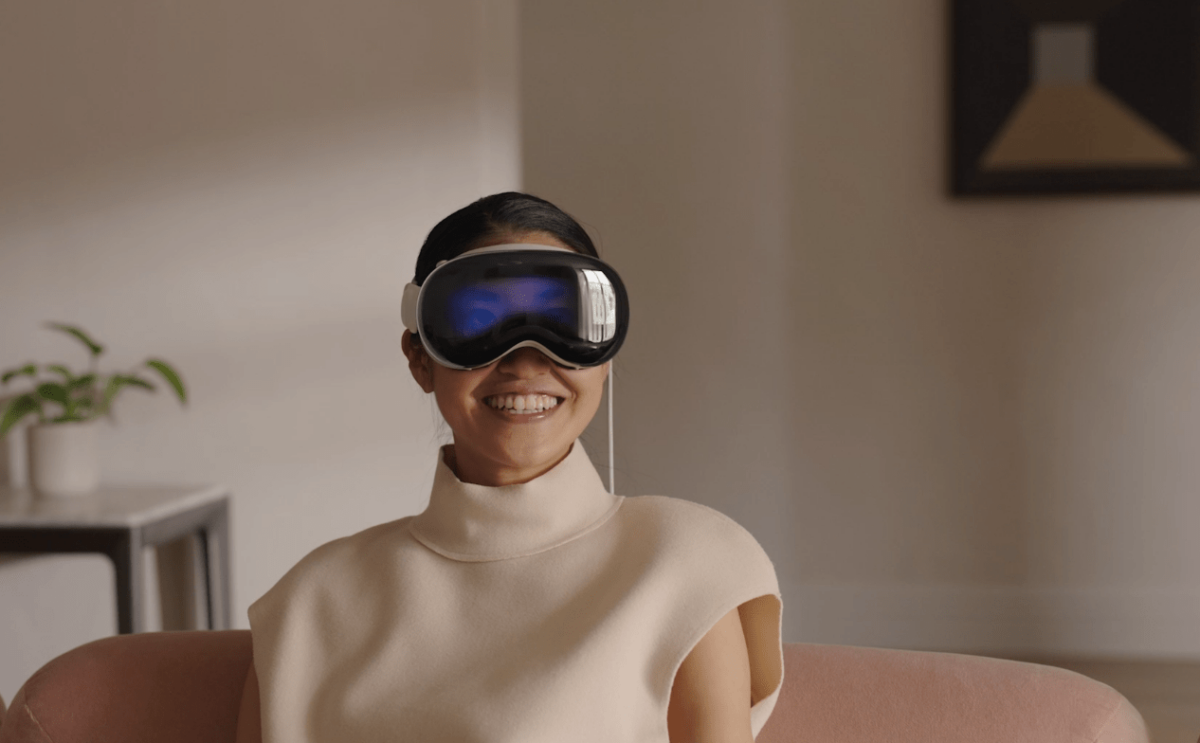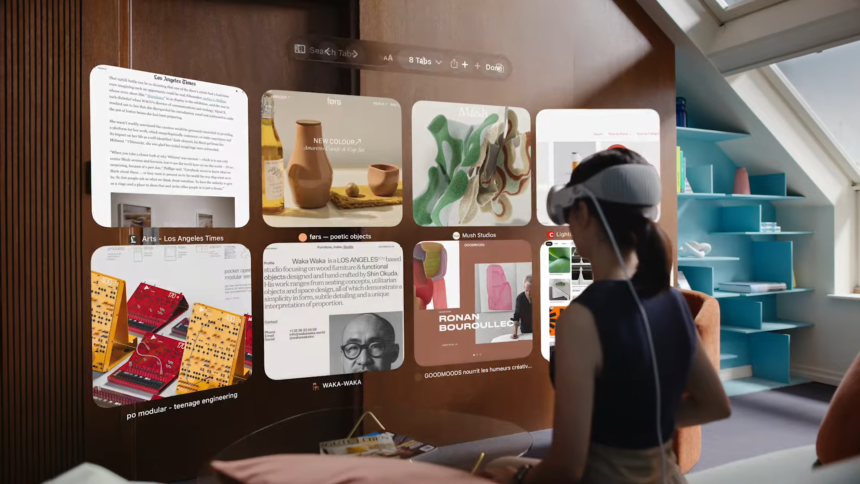Is the Apple Vision Pro a game changer for VR? A first analysis

I've been writing about virtual reality for the past seven years, and I'm both excited and disappointed by the announcement of the Apple Vision Pro. Here are my first thoughts.
Here it is at last, Apple's fabled mixed reality headset that the company has been working on for seven or more years. For the VR industry, the announcement of the Apple Vision Pro is the most significant event of the past decade, comparable only to Facebook's acquisition of Oculus in 2014.
Content
Apple’s first spatial computer is a VR headset
The unveiling of the device felt surreal to me. Because I'd been waiting for it for so long, and because the Vision Pro was ultimately anything but a typical Apple product.
You can turn it any way you want: The Apple Vision Pro is a headset by design, and as such, it's big, heavy, and uncomfortable to wear - despite the beauty of its design.
The first Apple ad for the device looks just as awkward and embarrassing as the ones from Meta and other manufacturers. A product that Steve Jobs would never have approved in this form. A sleek pair of AR glasses you can wear in public? Maybe. A face computer that looks like a scuba mask? Never.
I knew that even Apple couldn't perform miracles and skip the necessary technological evolution toward slimmer headsets. Still, I was a bit disappointed with how bulky the Vision Pro looks while worn.
The breakthrough in comfort that is so important to the technology is off the table for now, with or without the optional top strap that Apple showed off in passing.
Vision Pro is packed with innovations
But Apple wouldn't be Apple if it didn't push the envelope and make the competition look old when it comes to hardware design. Compared to devices like the Meta Quest Pro or the Varjo XR-3, the Apple Vision Pro looks like a headset from the future.
This is thanks to the ingenious design tricks we have come to expect from Apple. The best example I can think of is the external display, which turns the unadorned front of traditional headsets into a magical screen, giving the product an iconic futuristic look.
The external display has more than just aesthetic purposes: it displays the eyes of the headset wearer, allowing eye contact with the outside world. It's a unique feature that Apple calls "EyeSight," and I think it's the biggest and most fascinating innovation in the Apple Vision Pro.
The idea itself is not new: Meta showed a research prototype two years ago that basically does the same thing. But it's not the idea that matters, it's the implementation in a product. The sight of someone's eyes on a headset is unusual, eerie and dystopian, but it's definitely an innovation that will shape Apple Vision Pro, both technically and aesthetically.

The Apple Vision Pro also serves as a 3D camera. | Image: Apple
Another great innovation from Apple is that Vision Pro is an immersive recording and playback device in one. With the press of a button, headset wearers can record photos and movies in 3D. Until now, anyone who wanted to produce this kind of content had to buy a special VR camera, which is either very expensive or provides poor quality recordings. And transferring and viewing 3D photos and movies on a VR headset can be cumbersome. Apple Vision Pro combines the ability to capture, view, and share such content, which could be a game-changer for immersive media.
Other innovations of Apple Vision Pro that caught my eye, but won't be discussed in detail here include:
- A limitation to natural input methods (hands, eyes and voice) instead of controllers.
- A high-quality 3D audio solution that requires scanning of the ears (keyword: HRTF)
- Different types and sizes of headbands and facial interfaces
- Real-time display of realistic Facetime avatars
No reality shifts: Apple is pragmatic
Apple thinks of its first facial computer primarily in terms of augmented reality, although Vision Pro is technically a VR headset. The outside world is captured by sensors and digitally reconstructed on opaque displays, just like the eyes of the headset wearer on the external display.
The uninitiated might think that Apple Vision Pro is made of a transparent piece of glass, and that's exactly what Apple's marketing is going for. Or as Tim Cook said at the launch, "Vision Pro is the first Apple product you look through, not at."
In contrast, competitors' devices, such as the Meta Quest 2, are marketed primarily as virtual reality products. With the Meta Quest 3, Meta will focus more on augmented reality. Apple is taking the opposite approach: Vision Pro is primarily an augmented reality product, and virtual reality is just one mode of it.
Speaking of reality, it's a blessing that Apple has eschewed the industry's fixation on terms like VR, AR, MR, XR, and the indefinable "Metaverse". Apple isn't messing with reality; it's building a face device that specializes in spatial content. That's more concrete. And easier to communicate to the broader public.
Apple understands that the term "virtual reality" can conjure up fears or expectations that current technology cannot and may never meet. The goal is not to hack the human senses or replace reality, but something much more modest: Vision Pro, as the product is called, is limited to augmenting vision.
Apple kills VR’s killer apps
In the spirit of John Carmack, the company is marketing the headset as a universal display that can replace a variety of other screens, as well as a standalone mobile computer that doesn't require an iPhone or Mac. This is how Apple justifies the price of $3,499.
Apple has done a good job of communicating and visualizing what this futuristic device will be good for. However, it is highly questionable whether the application scenarios shown are enough to convince consumers to buy the device.
Tim Cook said that Vision Pro will change the way people communicate, collaborate, work, and consume entertainment, and Apple showed specific examples of each of these activities. But most of these use cases were reduced to projecting 2D screens into the physical 3D environment. You can't get more unimaginative than that.

This is how Apple envisions working with Vision Pro. The same image could have come from Meta. | Image: Apple
The two best and most commercially successful types of applications that VR technology has produced so far, gaming and fitness, were virtually absent from the presentation. At least it will be possible to play mobile 2D games on a virtual screen, as long as you have a compatible gamepad. A bad joke considering the possibilities offered by affordable VR technology in the form of Meta Quest 2 or Playstation VR 2. Independent VR studios from around the world have produced a high-quality portfolio of VR games since 2016 that might have no future on the Vision Pro because the device does not support VR controllers.
My fears were confirmed: Apple itself doesn't quite know what this technology is good for, and is hoping that the developer community will provide the crucial reason for its existence. More immersive communication, collaboration, work and entertainment: All these approaches have already been seen at Meta or elsewhere, and the trailers and concepts of both tech companies are mostly the same.
The question is whether Apple can add the critical value that Vision Pro needs through better implementation and integration into its own ecosystem. No one is going to buy this device for iPad apps floating around the room. Not in this form and not at this price.
Many questions remain
It was reportedly Tim Cook's decision to finally present the headset to the public rather than wait for technology to advance and allow for smaller, sleeker form factors. I got the sense from the presentation that Cook is really excited about the Apple Vision Pro and what it can do. In this respect, Tim Cook and Mark Zuckerberg may not be that far apart. Both believe in the technology, both are willing to invest in it, and both have similar use cases in mind.
In the end, I felt ambivalent about the announcement. The Vision Pro is a beautiful piece of technology. I admire the attention to detail that Apple's engineers have put into it, and the many innovations, large and small, that go into a device that will inspire the whole industry. Apple Vision Pro is indeed "the most advanced personal computer ever created." But what I and other consumers are ultimately supposed to do with it was not made clear to me yesterday.
Apple, like Meta and others, has a spatial general-purpose computer in mind, but it will take years to miniaturize the hardware and mature the software. I hope Apple takes its time because success won't come overnight.
Until then, I'm going to use my headsets for what I used it for yesterday after the Vision Pro was unveiled: VR gaming.
I put on the Playstation VR 2 and immersed myself in the endlessly fascinating sci-fi world of Red Matter 2. A game that seems made for this headset, which seems made for this game. For me, it's a unique VR experience, one that may never be available for Vision Pro. Because Apple doesn't support VR controllers.
Note: Links to online stores in articles can be so-called affiliate links. If you buy through this link, MIXED receives a commission from the provider. For you the price does not change.